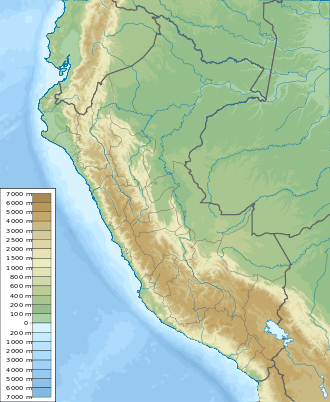Moray (Inca ruin)
Moray[1][2] (Quechua: Muray)[3] is an archaeological site in Peru approximately 50 kilometres (31 mi) northwest of Cuzco on a high plateau at about 3,500 metres (11,500 ft) and just west of the village of Maras. The site contains unusual Inca ruins, mostly consisting of several terraced circular depressions, the largest of which is approximately 30 m (98 ft) deep. As with many other Inca sites, it also has an irrigation system.
Muray | |
The Incan terraces at Moray | |
 Shown within Peru | |
| Location | Peru |
|---|---|
| Region | Cusco Region |
| Coordinates | 13°19′45″S 72°11′44″W |
| History | |
| Cultures | Inca |
The purpose of these depressions is uncertain, but their depth, design, and orientation with respect to wind and sun creates a temperature difference of as much as 15 °C (27 °F) between the top and the bottom.
Erosion threats to structure
During the rainy season of 2009–2010, the Department of Cusco received high levels of precipitation that are atypical, which caused permanent damage to the ruins of Moray. The terraced levels of the complex, which are constructed from stone and compacted earth, were damaged extensively as the excessive rain waters undermined the ground beneath the structure.
The eastern side of the principal circle collapsed during February 2010, causing concerns about the permanence of the site as a top tourist attraction in Peru. A temporary wooden support structure was erected to prevent further collapse until reconstruction work could begin.
According to travel writer Paul Jones,[2] "Although repair work at Moray continues to restore the site to its original state, lack of funds and continuing annual rainfall hinder progress. This interesting archaeological site which forms an important part of tourism to the region continues to be at risk of further degradation, should the repair work not be completed and maintained for the future years."
Origin
This landmark was likely used for farming, and soil samples have shown that soils were brought in from different regions to be used in helping grow crops at the different levels of the terraces. [4]
See also
References
- "ZONA ARQUEOLÓGICA DE MORAY". Inventario Turístico de Perú. MINCETUR. Retrieved 23 May 2017.
- Jones, Paul J (2012) author and travel writer, Peru Guide (the only), the online guide to Peru.
- Cristóbal Estombelo Taco, Inka taytanchiskunaq kawsay nintayacharispa, Instituto Superior Pùblico La Salle - PROYECTO CRAM II, Urubamba, Cusco 2002 (in Quechua)
- https://www.amusingplanet.com/2013/03/the-mysterious-moray-agricultural.html
| Wikimedia Commons has media related to Moray (Peru). |
External links
